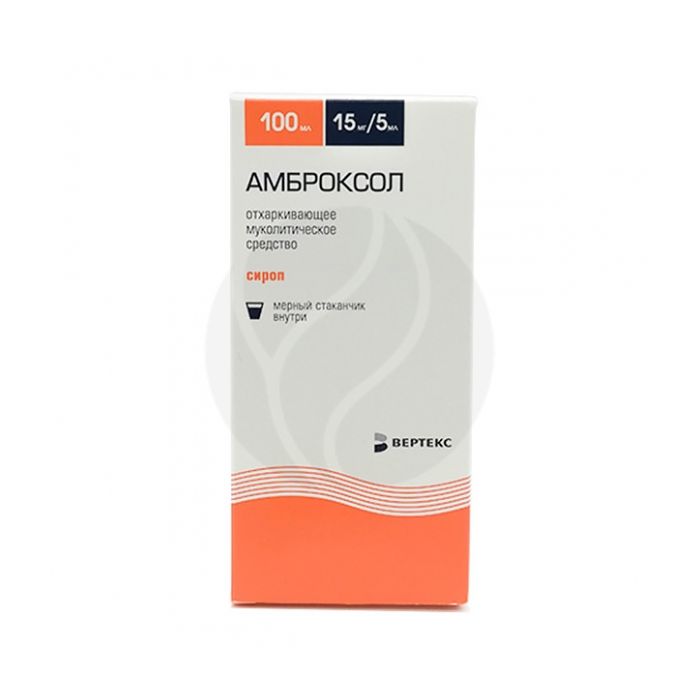Ambroxol syrup 15mg / 5ml, 100ml
Expiration Date: 05/2027
Russian Pharmacy name:
Амброксол сироп 15мг/5мл, 100мл
Diseases of the respiratory tract, accompanied by the release of viscous sputum and difficulty in passing sputum:
acute and chronic bronchitis;
pneumonia;
bronchial asthma;
bronchiectasis;
COPD.
The duration of treatment is determined by the doctor individually and depends on the severity of the disease. If it is necessary to use the drug for more than 4-5 days, a doctor's consultation is required.
For oral administration
It is taken orally after meals with a sufficient amount of liquid.
Dosage forms of normal duration of action (tablets, syrup, oral solution, lozenges)
Adults and children over the age of 12 years: 30 mg 2-3 times / day for the first 2-3 days, then 30 mg 2 times / day. Children aged 5 to 12 years: 30-45 mg / day in 2-3 doses. Children aged 2 to 5 years: 22.5 mg / day in 3 divided doses. Children under 2 years of age: 15 mg / day in 2 divided doses. The drug is prescribed only under the supervision of a physician.
ambroxol hydrochloride
Hypersensitivity to ambroxol or auxiliary components of drugs;
I trimester of pregnancy;
lactation period (breastfeeding);
congenital fructose intolerance (for dosage forms containing fructose);
children under 6 years of age (for tablets);
children under 12 years of age (for capsules of prolonged action).
With care: impaired bronchial motility and increased mucus secretion (for example, in the rare syndrome of motionless cilia); renal impairment and / or severe hepatic impairment; peptic ulcer and duodenal ulcer (including history); II and III trimesters of pregnancy; children under 2 years of age (oral solution; only as directed by a doctor).
pharmachologic effect
Mucolytic and expectorant agent, is an active N-demethylated metabolite of bromhexine. It has a secretory, secretolytic and expectorant effect. Stimulates serous cells of the bronchial mucosa, increases the motor activity of the ciliated epithelium by acting on type 2 pneumocytes in the alveoli and Clara cells in the bronchioles, enhances the formation of endogenous surfactant - a surfactant that ensures the sliding of bronchial secretions in the airway lumen. Ambroxol increases the proportion of the serous component in the bronchial secretion, improving its structure and helping to reduce the viscosity and dilute sputum; as a result of this, mucociliary transport is improved and the excretion of sputum from the bronchial tree is facilitated. When taking ambroxol orally, the effect, on average,occurs after 30 minutes and lasts 6-12 hours, depending on the single dose.
Pharmacokinetics
After oral administration, Ambroxol is rapidly and almost completely absorbed. Tmax is 1-3 hours. Plasma protein binding is approximately 85%. Penetrates through the placental barrier, excreted in breast milk. It is metabolized in the liver with the formation of metabolites (dibromantranilic acid, glucuronic conjugates), which are excreted by the kidneys. It is excreted mainly by the kidneys - 90% in the form of metabolites, less than 10% unchanged. T1 / 2 from plasma is 7-12 hours. T1 / 2 of ambroxol and its metabolites is approximately 22 hours. removal of ambroxol does not occur. Ambroxol clearance in patients with severe hepatic impairment is reduced by 20-40%.In severe renal failure, T1 / 2 of ambroxol metabolites increases.
Side effect
Allergic reactions: rarely - skin rash, urticaria, exanthema, swelling of the face, shortness of breath, itching, fever; frequency unknown - anaphylactic reactions, including anaphylactic shock, angioedema, pruritus, allergic contact dermatitis. From the digestive system: often - nausea; infrequently - vomiting, diarrhea, dyspepsia, abdominal pain. From the nervous system: often - dysgeusia. Skin and subcutaneous tissue disorders: very rarely - toxic epidermal necrolysis (Lyell's syndrome), Stevens-Johnson syndrome; frequency unknown - acute generalized eczematous pustulosis. From the respiratory system: often - decreased sensitivity in the mouth or pharynx; rarely - dryness of the mucous membrane of the respiratory tract, rhinorrhea; in isolated cases - dryness of the pharyngeal mucosa.
Application during pregnancy and lactation
Ambroxol is contraindicated in the first trimester of pregnancy. If it is necessary to use it in the II and III trimesters, the potential benefit of therapy for the mother and the possible risk to the fetus should be assessed. If it is necessary to use Ambroxol during lactation, the question of stopping breastfeeding should be resolved.
Application in children
Application is possible in accordance with the dosage regimen.
Use in elderly patients
The drug is approved for use in elderly patients
special instructions
Ambroxol should not be taken concomitantly with antitussive drugs that can inhibit the cough reflex, such as codeine. this can make it difficult to remove liquefied phlegm from the bronchi. Ambroxol should be used with caution in patients with a weakened cough reflex or impaired mucociliary transport due to the possibility of sputum accumulation. Patients taking ambroxol are not recommended to perform breathing exercises due to difficulty in sputum discharge. In critically ill patients, aspiration of liquefied sputum should be performed. You should not take Ambroxol just before bed. In patients with bronchial asthma, ambroxol may aggravate the cough.Patients with severe skin lesions - Stevens-Johnson syndrome or toxic epidermal necrolysis - may experience a flu-like condition in the early phase: fever, body pains, rhinitis, cough, pharyngitis. With symptomatic therapy, it is possible to erroneously prescribe mucolytic agents such as ambroxol hydrochloride.
Drug interactions
Antitussives (for example, codeine) - due to the suppression of the cough reflex, sputum may accumulate in the lumen of the respiratory tract with difficulty in removing it (simultaneous use is not recommended). Amoxicillin, doxycycline, cefuroxime, erythromycin - increased penetration of antibiotics into bronchial secretions.

